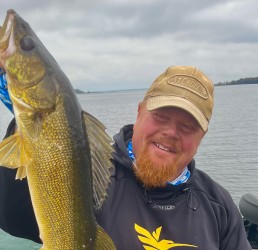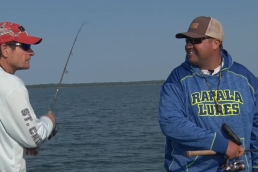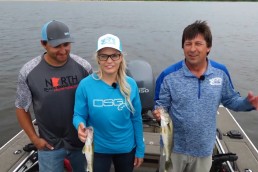Back to School for Big Fall Walleyes
SHARE THIS POST
Fall is one of the best times to catch numbers of hefty fish, as well as prime time for a chance at a personal best. The fish have fed on bug hatches, crayfish, young-of-the -ear and last year’s perch hatches all summer long, primarily during narrow feeding windows with optimum conditions for success. Now, walleyes are feeding more often throughout the day and hitting baits more aggressively.
This is the right time for using larger minnows as bait, as walleyes key in on bigger offerings. It’s not uncommon to drag 6- to 8-inch creek chubs, red tails and sucker minnows. Large leeches are scarce after walleyes loved them the most in late summer/early fall. One reasons for the larger bait preference: Most of the perch hatch, shiners and ciscoes have grown up in size. For years, anglers in the North Country anglers have been rigging big minnows in fall for the chance at a bigger bite. (Hint: If there’s a walleye tournament coming to your area, bait shops will sell out of large minnows; plan ahead!)
Targeting eaters or big walleyes?
Do large walleyes school with eater-sized walleyes? By this time of year, most 15- to 18-inch walleyes are schooled up, feeding on flats, weed edges and sometimes deep, hard-bottom areas. Large walleyes, from individuals to less than a dozens, will be nearby, hunting steep breaklines or suspending off the edge, waiting for a bigger minnows/baitfish to stray within its striking range. If the water is cooler (40s to 50s), walleyes get a chance to eat a better piece of meat, such as cisco. Some deep lakes also have smelt, a cold-water bait species, that dwells in the basin or in the thermocline.
Rather than a never-ending chase in open water, steep breaks allow walleyes to chase a baitfish ball (suspended school) up against a wall for a better chance of success. I like steep edges; if the drop-off goes from 15 to 40 feet, drag a rig with a big minnow at a depth in the low 20s. Walleyes that are above or below, hunting along the breakline, are within close striking distance.
When you mark a school of eaters this time of year, you may find 20 to 50 fish in a small area of less definition—flats, gradual points and green weed edges. Big fish will be in steep corners on top of large boulders, and green weeds that are adjacent to a steep edge or channel.
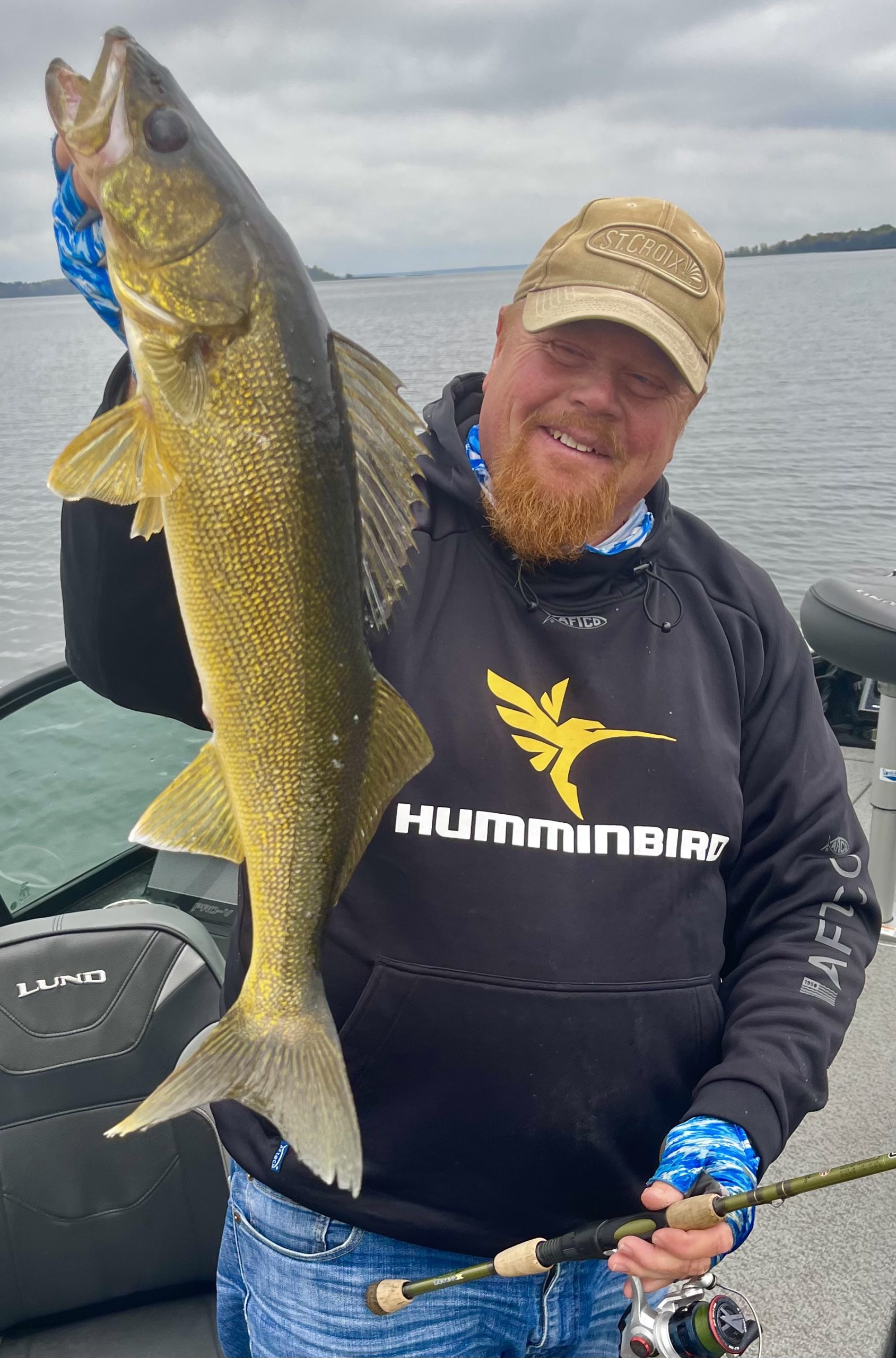
Refining your search
Larger lakes can hide a school of walleyes like a needle in a haystack. It’s a process of checking breaklines at the targeted depth for miles. Technology advancements help narrow the chase with a few pushed buttons. My Humminbird SOLIX with LakeMaster maps allows me to highlight break lines and key depths. In my guided walleye areas, I know where to fish with limited searching; but when I fish other large waters, I lean on my LakeMaster maps with highlighted features to cut the search miles down. Humminbird MEGA Side Imaging or 360 are my first approach before forward viewing; I can drop off plane and start looking. With forward viewing, you must drop down the trolling motor or a down rod.
When I spot a pod of fish, that’s when I use MEGA Live forward viewing, mounted on my Minn Kota Ultrex QUEST trolling motor, to look and gauge the size of the fish and their distance from the bottom. When I’m targeting larger walleyes, I only fish if the size looks big! I then Spot-Lock 40 feet upwind or downwind of the fish. I have been able to lock in closer to walleyes without spooking them because the Minn Kota QUEST series is brushless, which makes them ultra-quiet.
Bro Tip: My Lund is large and heavy. I use two lithium 36-volt batteries connected in parallel; this allows twice as much run time on your front trolling motor and helps me survive the day spot-locked in big wind, large waves and strong current.
Suspend, drag or pitch?
Now that you have fish within your sights, what should you throw?
Are you enjoying this post?
You can be among the first to get the latest info on where to go, what to use and how to use it!
Slip bobbers have become very popular to throw at the level of the fish. Drag a nightcrawler or leech tipped on a tungsten short-shank jig up to their noses and let it soak until they bite. However, on windy days, bobbers quickly drift away from the fish and large waves make fishing even worse.
In rough-water conditions, drop-shot rigs presented at the walleye’s level allow you to drag the drop-shot hook up to the walleye’s nose, and using heavy weight negates the effects of wind and waves.
Pitching is my favorite tactic, using a 1/4- to 3/8-ounce Northland MVP jig head with a wicked Gamakatsu hook that will pierce a big walleye’s bony mouth. Add one of the new, 4-inch Eye-Candy Paddle Shad soft plastic. Pitch it past the fish—not above them. Then slowly swim the paddle shad past the walleyes. When they strike, reel until the tip of the rod bends under the weight of the walleye strike, then set the hook. If they pass up the offering, pitch an Eye-Candy Minnow past them, very lightly jigging and slowly moving the reel handle. The plastic is super soft so it moves with the slightest amount of motion.
Add scent for better results. There are many scent companies on the market. The trick is to scent up one tail at a time, not the entire package at once. Mild scents that cater to walleyes are best rather than strong pungent scents.
I use a St. Croix Legend Elite 6’8” to 7’ Medium Extra Fast rod for pitching. For bobbers or drop-shots, my preference is a St. Croix Avid 7’ with a light SEVIIN GX 2000 reel.
Bro Tip: On lakes with zebra mussels, use a 3- to 6-foot clear fluorocarbon leader. It is resilient to the sharp edges of zebra mussels that are on weed stalks and over the rocks.
If normal presentations don’t work, find another pod of fish and check back on this group later. It could be a matter of timing.
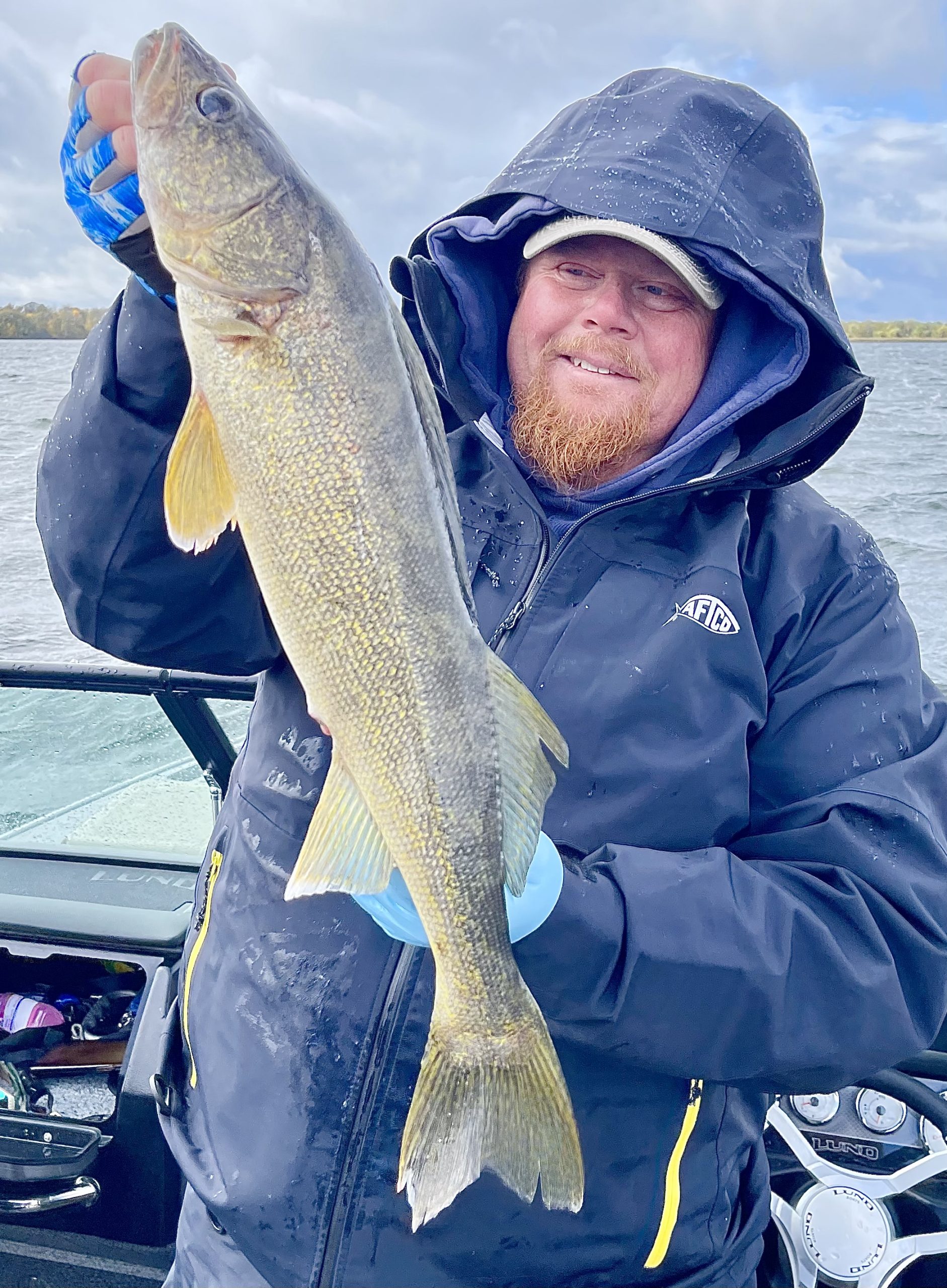
Fish movement
No matter the season, walleyes swim around constantly moving—especially on the lading edge of a storm front or moderate change in barometric pressure. However, as pressure lowers, walleyes lay belly to the bottom, and anglers have to focus on their electronics. If you are not seeing walleye movement, they are probably hunkered down. They will show up nicely on Side Imaging as a lumpy bottom similar to rocks, but with the shape of a walleye and a shadow close to them.
Further into fall (before freeze-up), large numbers of loons show up and hang around the lake’s basin, like humans at an airport terminal waiting to board their plane. Loons gather and then leave, avoiding winter and freeze-up. This usually coincides with the big walleye feeding binge. Whitefish come up from the deep basin into shallow weeds to spawn when water temperatures are in the low 40s. This is my favorite time of year to rig large creek chubs or sucker minnows on steep breaks near whitefish spawning areas. Besides the weeds on steep breaks, explore river channels or neck downs to other bays, as well as dams near reservoirs and rivers. Walleyes will stay in these areas up thru early ice; this is where anglers have their first-ice big walleye spot! When temperatures drop, I wear an AFTCO Hydronaut Insulated Jacket and Bibs and Fish Monkey Wooly Gloves so being cold on the water isn’t an issue.
Bro Tip: When water temperatures drop below 35 degrees, algae stops growing, creating a darker, murky cloud in the water as it disintegrates. Offshore winds spread the cloud outward, which is best. Winds blowing into shore negate the cloud!
This is a great spot for walleyes to hide in shallow water on clear lakes. That’s why shorelines and bays slow down and become great when other anglers have given up. I pitch a Deep-Vee Spin Jig with a paddle tail. The big Willow spinner gets the walleyes’ attention in murky water.
I hope you catch your personal best walleye this fall! Good luck!
MWO
SHARE THIS POST
Did you enjoy this post?
You can be among the first to get the latest info on where to go, what to use and how to use it!
Brian 'Bro' Brosdahl
Outdoor communicator Brian “Bro” Brosdahl lives in northern Minnesota. He is a walleye guide in the Cass Lake, Leech Lake and Lake Winnibigoshish areas. He is sponsored by Northland Fishing Tackle, Frabill/Plano, Aqua-Vu, Humminbird/Minn Kota, St. Croix Rods, Ranger Boats, and Evinrude. Guide inquiries: brosguideservice.com. Follow on social media.
